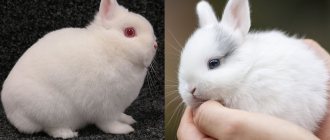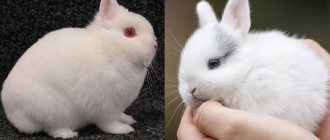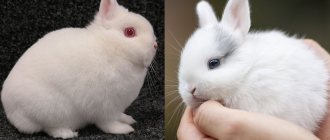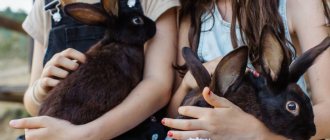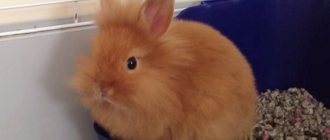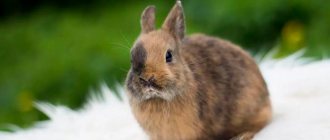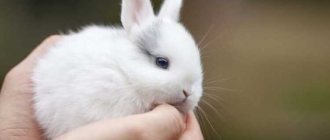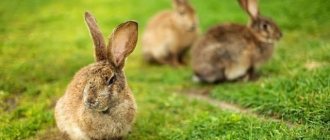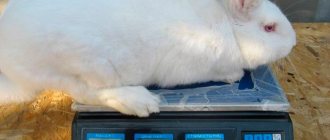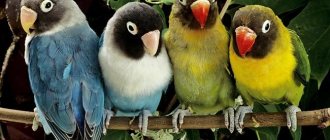Fold-eared decorative rabbits are funny animals with a protruding forehead and a short, blunt nose. They appeared as a result of intense breeding work and quickly gained fame as ideal pets.
Let's figure out what lies behind the external charm of decorative lop-eared rabbits and how to properly care for them.
Appearance
The Netherland or Dutch Fold rabbit is the smallest of all sheep. It weighs only 1.5-2 kg and is up to 25 cm long.
The appearance of a typical representative of a decorative breed should fall under the following description:
- The head is wide, with a short blunt nose, a pronounced nape, a protruding forehead and large eyes.
- The ears are long, thick at the base and rounded at the tips. They are turned with their shells inward and hang down on both sides of the muzzle.
- The body is compact, cylindrical, with a short neck, massive chest, spherical back and short tail.
- The coat is short and soft. The color is blue, opal, red, white, cheetah, chinchilla, black and even sable.
On a note. In addition to the Dutch, there are also German and French rabbits of the lop-eared sheep breed. But the latter are distinguished by their impressive size and are bred for meat.
French ram rabbit
Tendency to diseases
The most vulnerable places in rabbits are the ears and skin. Ear diseases can occur due to insufficient hygiene, especially for representatives of fold-eared breeds. As for skin diseases, all kinds of dermatitis (including allergic) also occur.
Colds are an item that should not be overlooked by the owner of rabbits of any breed. It is important to note that any disease in rabbits requires timely diagnosis and the help of a specialist, since improper self-treatment of a pet can lead to bad consequences.
Character and behavior
The decorative lop-eared lamb is endowed with a calm and good-natured disposition. A curious pet willingly explores new territories and quickly gets used to its owners.
The Dutch rabbit makes excellent contact and often becomes a full-fledged participant in children's games. He gets along well with peaceful non-hunting dogs and cats.
Interesting! Lop-eared rabbits have a less timid nature because their drooping ears muffle sudden loud noises.
Productive qualities
As a rule, sheep rabbits are bred for decorative purposes. However, these animals have excellent productive qualities. One of the main advantages of the breed is the precocity of rabbits and rapid weight gain.
At the age of 5–7 months, when rabbits reach sexual maturity, they already weigh from 1.5 to 3 kg, with the greatest growth dynamics observed up to 3 months. The final height and weight of animals are formed at the age of 6–8 months.
Of course, the rate of body weight gain is considered one of the most important productive characteristics for farmers breeding sheep and rabbits for the purpose of selling meat products. With increased and high-quality nutrition, some individuals are able to gain weight up to 10 kg.
Important! Rams
are quite voracious rabbits, so if keeping these animals has a decorative purpose, then it is very important for breeders to monitor their diet.
Obesity can provoke health-threatening diseases, in particular, damage to the liver, heart, and disruption of the digestive tract. In addition to high meat performance, lamb rabbits can boast of high-quality and valuable fur. The animal's skin is soft, dense, the wool is thick and silky, with a beautiful uniform color.
Health and life expectancy
On average, a decorative lop-eared rabbit can live about 5 years. But if he is provided with appropriate maintenance and care, there is a chance that he will live twice as long.
The dwarf lop-eared rabbit is predisposed to myxomatosis and hemorrhagic disease. To protect the animal from possible infection, it is subjected to preventive vaccination.
The first vaccination for an ornamental pet is given at the age of 45 days or after its weight reaches 500 g. 10 days before vaccination, the animal is given anthelmintic drugs.
You can understand that a decorative lop-eared rabbit is not feeling well by the following symptoms:
- increased body temperature;
- lack of appetite;
- loss of interest in games;
- lethargy;
- dulling of the coat.
If the above signs appear, the decorative rabbit must be taken to the veterinarian.
Important! Many diseases of dwarf rabbits occur hidden. Therefore, it is recommended to subject decorative pets to preventive veterinary examinations once every six months.
Price
You cannot buy a “rabbit in a poke”. Before purchasing, the animal must be carefully examined:
- A healthy pet should have a cold and wet nose;
- the eye sclera should be shiny and clean;
- Frequent scratching and matted fur may indicate fleas;
- An animal that constantly licks the anus and tries to sit on the floor with its backside may be infected with worms;
- Diseases of the internal organs may be indicated by cloudy eyes, protruding bones, and an empty, sagging abdomen;
- Bald spots on the body indicate infection with lichen.
The price of a lop-eared ram rabbit varies depending on the pedigree, beauty and rarity of the breed. An ornamental animal without a pedigree costs from 1 to 2 thousand rubles. A pet-class lop-eared cat costs on average from 1 to 2.5 thousand rubles.
If the owners intend to breed a certain breed, it is necessary to purchase a breed-class rabbit-ram, for which they will have to pay from 2 to 4 thousand rubles.
Handsome men with pedigree displayed at exhibitions (show class) are valued at 3-5 thousand rubles. Prices for beautiful and very rare breeds, for example, Dutch Folds, can reach up to 8 thousand rubles.
The purchase should be made during the period when wool does not grow. This will allow you to carefully examine the coat for bald spots.
Maintenance and care
Representatives of the lop-eared sheep breed are afraid of overheating, drafts, dampness and hypothermia. Therefore, the room where decorative rabbits live should be light, warm and dry.
Fold rabbits do not tolerate tobacco smoke, ammonia fumes and high concentrations of carbon dioxide. Therefore, the rooms in which they are kept must be regularly ventilated.
Home improvement
To live comfortably at home, a fold-eared ram needs a spacious cage, the dimensions of which are at least 50x70 cm. It must be made of high-quality durable metal and have a plastic tray.
There should be no burrs or sharp edges on the inner surface of the cage, on which a dwarf pet could accidentally injure its long drooping ears.
In their natural environment, rabbits live in burrows and feel uncomfortable in the absence of shelter. Therefore, it is advisable to install a house in the fold sheep’s cage in which the pet could hide. It is also recommended to place a food bowl, drinking bowl, mineral stone for grinding teeth and a tray there.
On a note. Experts do not recommend rushing to arrange the rabbit “furniture”. First, you need to see which corner your pet will choose for going to the toilet, and only then you can place the tray there.
Hygiene procedures
In order for the dwarf rabbit lop-eared ram to look neat, you need to properly care for it:
- The animal's claws are regularly shortened with a nail clipper. If this is not done in a timely manner, the pet will ruin the floor.
- The ears of a decorative rabbit are regularly inspected for inflammation and carefully cleaned with cotton swabs soaked in a weak solution of boric acid.
- The fur coat of the decorative animal is periodically combed with a special brush with natural bristles. But bathing an animal unless absolutely necessary is not recommended. True, the white lop-eared rabbit gets dirty more than its colored counterparts and needs to be washed.
Taming and walking
Caring for a lop-eared rabbit will be much easier if you train it to be handled.
In order for the animal to adapt faster, you need to follow a few simple recommendations:
- Upon arrival home, the little rabbit is immediately sent into a cage and allowed to get used to its new home. The door is left unlocked so that the pet can get out freely.
- Talk to the rabbit in a calm and affectionate tone so that the animal is not frightened by a sharp loud sound.
- In order for the pet to quickly get used to the hands, he is often treated to some kind of treat. At first, the lop-eared rabbit will grab the tasty treat from the palm of your hand and run away, but then it will stop being afraid.
- You can come up with a nickname for the animal and constantly call it by name. Gradually, the fold-eared ram will get used to it and begin to respond to the call.
Interesting! Although rabbits are difficult to train, if desired, they can be taught simple tricks such as standing on their hind legs.
So that the dwarf representative of the lop-eared ram does not lack movement, he cannot be kept locked up all the time. The rabbit must be allowed to run around the room every day.
The decorative lop-eared rabbit does not need walks in the fresh air. But if the pet is nevertheless taken outside, it must be put on a harness and leash.
Housing
Domestic lop-eared rabbits love to live in spacious cages. This is one of the conditions for their proper maintenance. The cage must have a drinking bowl with clean water and a feeder. It is necessary to provide the animal with sufficient space for movement. These are the conditions that will be ideal for keeping lop-eared animals.
Recommendation! The floor in the cage should be solid and without protrusions, as this can injure the animal.
The cage should be placed in an area of the room where direct rays of the sun do not fall. There should also be no drafts in the room. These factors can negatively affect your pet's health.
Feeding
In order for dwarf lop-eared rabbits to remain healthy and active longer, they need to be fed properly. The basis of the diet of representatives of the decorative breed should be hay and grain mixtures. The latter can not only be bought in a specialized store, but also made with your own hands from wheat, oats, corn and sunflower.
From the age of six months, the diet of lop-eared rabbits is supplemented with fresh vegetables, fruits and dried grass. All these products are given to animals occasionally and in small quantities.
You cannot feed rabbits milk, meat, chocolate, sweets, baked goods or any food from the master's table.
Reproduction and offspring
Only completely healthy, vaccinated individuals that do not have external defects are allowed for breeding.
On a note. To reduce the risk of getting non-standard offspring, breeders recommend selecting partners of the same color. In other words, a black lop-eared rabbit is mated with a black one, a white one with a white one, etc.
For successful fertilization, the female is placed with the male and immediately after mating is removed. If mating is successful, after about a month 3-4 cubs are born. Rabbits are born naked and blind. Therefore, the mother carefully licks them and covers them with down.
After 2 weeks, the babies open their eyes, and by 40 days of age they become completely independent.
Flaws
If you don't monitor your pet carefully enough, it can cause damage to furniture, wires and other property.
The animal sheds regularly, so you need to clean the cage and the area around it daily. When caring for your pet, you need to pay special attention to cleaning the ears, and also remember to comb the hair and trim the nails at least once every three months.
The animal is afraid of loud sounds, sudden movements and bright light; keep this in mind when deciding to purchase this animal. If your home is always noisy, for example, there are a lot of children, consider whether it is worth buying an animal so that it is constantly stressed and sick.
How to choose a pet
Rabbits of the dwarf fold ram breed are born with straight ears and acquire a characteristic appearance only by 2-3 months. Therefore, it is advisable to buy them no earlier than this age and only from trusted breeders.
When choosing a decorative lop-eared rabbit, it is recommended to pay attention to:
- for the presence of a pedigree and veterinary passport;
- health status;
- compliance with the breed standard;
- conditions of detention;
- behavioral features.
Features of choosing a rabbit
You need to buy a baby rabbit after its ears have drooped (so as not to doubt the breed) and at the same time before puberty occurs, since from this moment on, taming the animal becomes much more difficult.
You can take a baby rabbit if its ears have already drooped
You need to buy an animal from a reliable nursery or a large pet store. The seller must provide documentation regarding vaccinations and treatment of the animal against worms and skin parasites.
Before purchasing, you need to make sure that the future pet is healthy
Despite all the attractive appearance of rabbits, before you buy an animal, you need to examine it for diseases. A healthy animal should have: good thick hair without bald spots, clean nose, eyes and ears and sufficient physical activity. You also need to remember that if a rabbit is very timid, this is an indicator of the presence of psychological trauma, which is difficult to cope with, and therefore it is better to choose a different pet.
